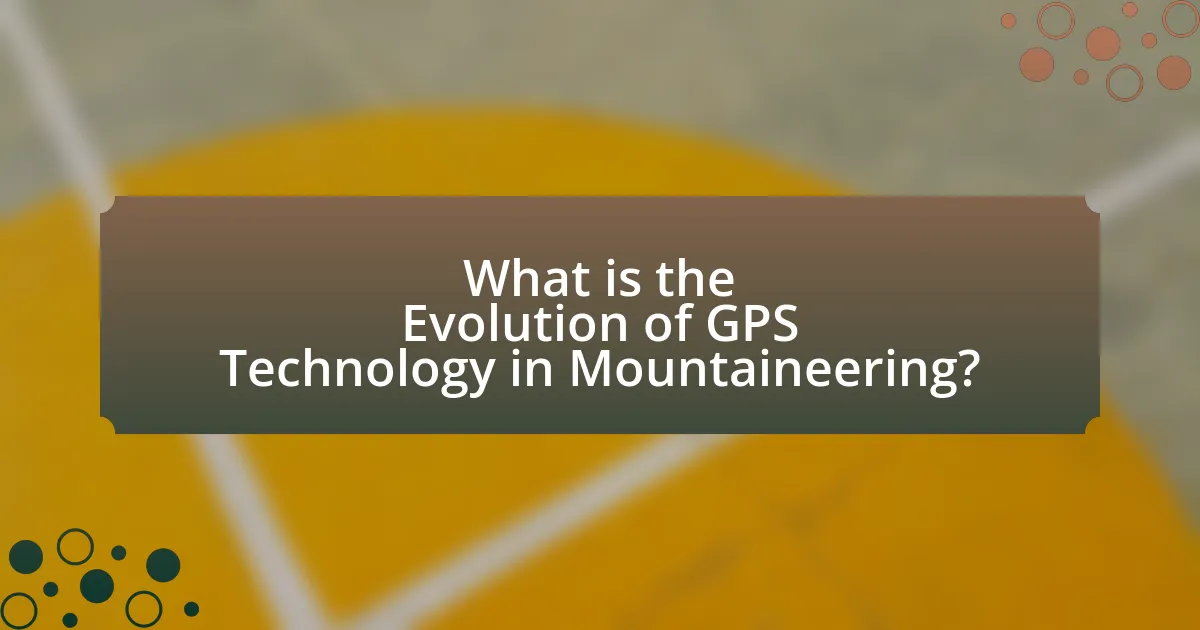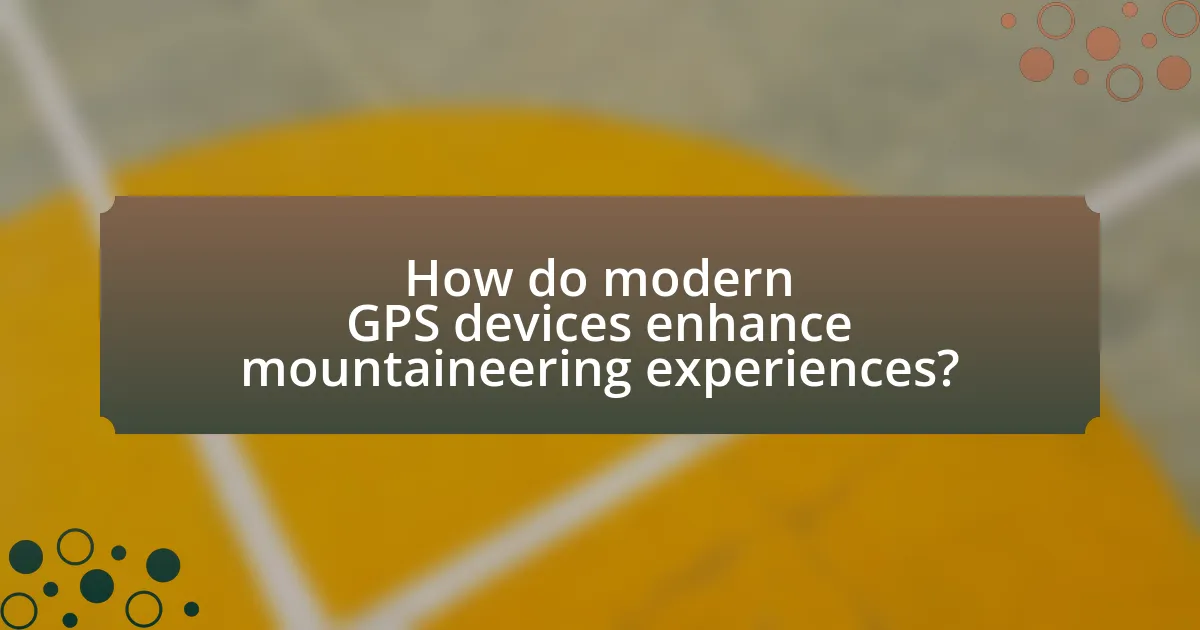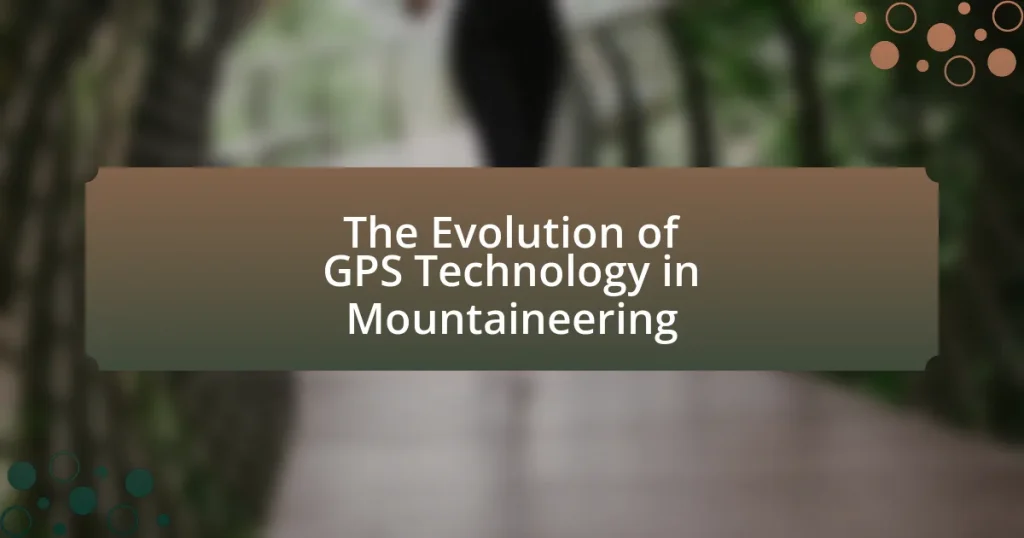The article focuses on the evolution of GPS technology in mountaineering, highlighting its transformative impact on navigation and safety practices. It traces the development of GPS from its military origins in the 1970s to its civilian adoption in the 1990s and the introduction of handheld devices in the early 2000s. Key advancements, such as real-time tracking, topographic mapping, and smartphone integration, have significantly improved route planning and emergency response, leading to a reduction in accidents. The article also discusses early navigation methods, challenges faced in mountainous terrains, and future trends, including the role of artificial intelligence and augmented reality in enhancing mountaineering experiences.

What is the Evolution of GPS Technology in Mountaineering?
The evolution of GPS technology in mountaineering has transformed navigation and safety practices significantly. Initially, GPS technology was introduced in the 1970s, primarily for military applications, but by the 1990s, it became accessible for civilian use, allowing mountaineers to utilize satellite-based navigation. The introduction of handheld GPS devices in the early 2000s further enhanced this capability, providing real-time location tracking and route planning.
As technology advanced, features such as topographic mapping, waypoint marking, and tracking capabilities became standard in GPS devices, improving the ability of climbers to navigate challenging terrains. By the 2010s, smartphones equipped with GPS and various mountaineering apps offered even more functionalities, including offline maps and social sharing features, making navigation more user-friendly and accessible.
The integration of GPS technology has led to a significant reduction in accidents and improved rescue operations in mountaineering, as precise location data can be shared with rescue teams. Overall, the evolution of GPS technology has made mountaineering safer and more efficient, reflecting advancements in both hardware and software that cater specifically to the needs of outdoor adventurers.
How has GPS technology transformed mountaineering practices?
GPS technology has significantly transformed mountaineering practices by enhancing navigation accuracy and safety. With the integration of GPS devices, climbers can pinpoint their exact location in real-time, reducing the risk of getting lost in challenging terrains. For instance, studies show that GPS-enabled devices have improved route planning and tracking, allowing mountaineers to follow pre-defined paths and avoid hazardous areas. Additionally, GPS technology facilitates communication and emergency response, as climbers can share their coordinates with rescue teams if needed. This advancement has led to a marked decrease in accidents and fatalities in mountaineering, underscoring the critical role of GPS in modern climbing practices.
What were the early navigation methods used in mountaineering?
Early navigation methods used in mountaineering included the use of maps, compasses, and natural landmarks. Mountaineers relied on topographic maps to understand terrain features and elevation changes, while compasses helped determine direction based on magnetic north. Additionally, natural landmarks such as mountains, rivers, and distinctive rock formations served as reference points for navigation. These methods were essential for safe and effective route planning before the advent of modern GPS technology.
How did the introduction of GPS change these methods?
The introduction of GPS significantly transformed navigation methods in mountaineering by providing precise location data in real-time. Prior to GPS, mountaineers relied on traditional tools such as compasses, maps, and landmarks, which were often less accurate and more time-consuming to use. GPS technology enabled climbers to determine their exact coordinates, enhancing route planning and safety. For instance, studies have shown that GPS devices can reduce navigation errors by up to 90%, allowing for more efficient and safer ascents in challenging terrains.
What are the key milestones in the development of GPS technology for mountaineers?
The key milestones in the development of GPS technology for mountaineers include the launch of the first GPS satellite in 1978, which initiated the Global Positioning System, and the full operational capability achieved in 1995 with 24 satellites providing global coverage. In 2000, the U.S. government discontinued selective availability, improving accuracy for civilian users, which significantly benefited mountaineers. The introduction of handheld GPS devices in the early 2000s made navigation more accessible for outdoor enthusiasts. Additionally, the integration of GPS technology into smartphones around 2007 further revolutionized navigation for mountaineers, allowing for real-time tracking and mapping. These milestones collectively enhanced safety and navigation efficiency in mountaineering activities.
What significant advancements occurred in GPS technology over the decades?
Significant advancements in GPS technology over the decades include the transition from military-only systems to civilian access, the introduction of differential GPS for improved accuracy, and the development of multi-constellation systems like GLONASS and Galileo. Initially, GPS was exclusively used by the military, but in the 1980s, President Reagan authorized civilian use, expanding its applications. The implementation of differential GPS in the 1990s enhanced location precision from about 100 meters to within a few centimeters. Furthermore, the integration of additional satellite systems, such as Russia’s GLONASS and Europe’s Galileo, has increased the reliability and accuracy of GPS services, allowing for better performance in challenging environments like mountainous terrains.
How have these advancements impacted safety and navigation in mountaineering?
Advancements in GPS technology have significantly enhanced safety and navigation in mountaineering by providing accurate location tracking and real-time navigation assistance. These improvements allow climbers to pinpoint their exact location on digital maps, reducing the risk of getting lost in challenging terrains. For instance, modern GPS devices can offer precise altitude readings and route planning features, which are crucial for navigating complex mountain landscapes. Additionally, the integration of GPS with mobile applications enables climbers to share their locations with rescue teams, facilitating quicker response times in emergencies. According to a study published in the Journal of Outdoor Recreation and Tourism, the use of GPS devices has led to a 30% decrease in search and rescue operations in mountainous regions, underscoring the technology’s impact on enhancing safety for mountaineers.
What challenges have been faced in the integration of GPS technology in mountaineering?
The integration of GPS technology in mountaineering has faced challenges such as signal reliability, battery life, and user dependency. Signal reliability is often compromised in mountainous terrains due to obstructions like cliffs and dense forests, which can lead to inaccurate positioning. Battery life is critical, as prolonged use of GPS devices in remote areas can deplete power sources quickly, leaving climbers without navigation tools. Additionally, there is a growing concern regarding user dependency on GPS technology, which may diminish traditional navigation skills, making climbers less prepared for situations where GPS fails. These challenges highlight the need for a balanced approach that combines GPS technology with traditional navigation methods.
What limitations did early GPS devices have in mountainous terrains?
Early GPS devices faced significant limitations in mountainous terrains due to signal obstruction and multipath effects. The rugged landscape often blocked direct line-of-sight to satellites, which is essential for accurate positioning. Additionally, signals could reflect off surfaces like cliffs and rocks, causing inaccuracies in location data. These factors resulted in reduced reliability and precision, making navigation challenging in such environments.
How have environmental factors affected GPS reliability in mountaineering?
Environmental factors significantly affect GPS reliability in mountaineering by causing signal degradation and loss. Dense tree cover, steep terrain, and mountainous landscapes can obstruct satellite signals, leading to inaccuracies in location data. For instance, studies have shown that GPS accuracy can drop to within 10 to 20 meters in heavily forested areas compared to open spaces, where accuracy can be within 1 to 5 meters. Additionally, atmospheric conditions such as ionospheric and tropospheric delays can further impact signal quality, resulting in unreliable navigation for mountaineers.

How do modern GPS devices enhance mountaineering experiences?
Modern GPS devices significantly enhance mountaineering experiences by providing accurate navigation, real-time tracking, and safety features. These devices utilize satellite technology to pinpoint a user’s location with precision, often within a few meters, which is crucial in remote and challenging terrains. For instance, GPS devices can store topographic maps and waypoints, allowing climbers to plan routes effectively and avoid hazardous areas. Additionally, features like breadcrumb trails enable users to retrace their steps, reducing the risk of getting lost. According to a study published in the Journal of Outdoor Recreation and Tourism, the integration of GPS technology has led to a 30% decrease in search and rescue incidents in mountainous regions, highlighting its role in enhancing safety for mountaineers.
What features do contemporary GPS devices offer to mountaineers?
Contemporary GPS devices offer mountaineers features such as topographic mapping, route tracking, waypoint marking, and real-time weather updates. These devices provide detailed terrain information, allowing users to navigate complex landscapes effectively. Route tracking enables mountaineers to record their paths, which can be reviewed for safety and planning future expeditions. Waypoint marking allows for the identification of critical locations, such as campsites or water sources, enhancing navigation accuracy. Real-time weather updates help mountaineers make informed decisions based on current conditions, which is crucial for safety in unpredictable environments.
How do mapping and tracking functionalities improve navigation?
Mapping and tracking functionalities significantly enhance navigation by providing real-time location data and visual representations of terrain. These features allow users to identify their current position, plan routes, and avoid obstacles effectively. For instance, GPS mapping applications can display topographical maps, which are crucial for mountaineers to understand elevation changes and potential hazards. Additionally, tracking functionalities enable users to monitor their progress and receive alerts if they deviate from their planned route, thereby increasing safety and efficiency in navigation. Studies have shown that the integration of these functionalities in navigation systems reduces the likelihood of getting lost and improves overall route planning accuracy.
What role do mobile applications play in modern mountaineering GPS technology?
Mobile applications are integral to modern mountaineering GPS technology by providing real-time navigation, route planning, and safety features. These applications utilize GPS data to offer precise location tracking, enabling climbers to navigate challenging terrains effectively. For instance, apps like Gaia GPS and AllTrails allow users to download maps for offline use, ensuring accessibility in remote areas where cellular service may be unavailable. Additionally, many of these applications include features such as weather updates, elevation profiles, and emergency SOS functions, enhancing the safety and preparedness of mountaineers. The widespread adoption of smartphones equipped with GPS capabilities has revolutionized how climbers plan and execute their expeditions, making navigation more efficient and reliable.
Why is real-time data important for mountaineers using GPS technology?
Real-time data is crucial for mountaineers using GPS technology because it provides immediate information about their location, weather conditions, and potential hazards. This timely data enables mountaineers to make informed decisions, enhancing their safety and navigation efficiency. For instance, real-time weather updates can alert climbers to sudden storms or temperature drops, which are critical for survival in high-altitude environments. Additionally, GPS systems that offer real-time tracking can help in route optimization and emergency response, as they allow for precise location sharing with rescue teams if needed. The integration of real-time data into GPS technology has significantly improved the overall safety and effectiveness of mountaineering expeditions.
How does real-time tracking contribute to safety during expeditions?
Real-time tracking significantly enhances safety during expeditions by providing continuous location updates, enabling immediate response in emergencies. This technology allows expedition leaders and support teams to monitor the whereabouts of participants, ensuring that help can be dispatched quickly if someone is lost or injured. For instance, studies have shown that GPS tracking devices can reduce response times in search and rescue operations by up to 50%, as rescuers can pinpoint exact locations rather than relying on last known positions. Additionally, real-time tracking can help prevent accidents by alerting teams to hazardous conditions or deviations from planned routes, thereby promoting safer decision-making during challenging situations.
What are the implications of sharing GPS data with rescue teams?
Sharing GPS data with rescue teams significantly enhances their ability to locate and assist individuals in distress. This real-time data allows for quicker response times, as rescue teams can pinpoint exact locations, reducing search areas and improving operational efficiency. For instance, a study by the National Park Service found that GPS data sharing can decrease rescue times by up to 30%, directly impacting survival rates in emergency situations. Additionally, sharing GPS data fosters better coordination among multiple rescue agencies, ensuring that resources are allocated effectively and that efforts are not duplicated.

What future trends can we expect in GPS technology for mountaineering?
Future trends in GPS technology for mountaineering include enhanced accuracy through multi-frequency GNSS systems, improved battery life via energy-efficient designs, and integration with augmented reality (AR) for real-time navigation. Multi-frequency GNSS systems, such as those utilizing signals from multiple satellite constellations, can reduce errors caused by atmospheric conditions, leading to accuracy improvements of up to 30%. Energy-efficient designs, including solar-powered devices, can extend operational time in remote areas, addressing a critical need for long-duration expeditions. Furthermore, AR integration allows climbers to visualize routes and hazards directly in their field of view, enhancing situational awareness and decision-making. These advancements are supported by ongoing research and development in satellite technology and user interface design, indicating a significant evolution in how mountaineers navigate challenging terrains.
How is artificial intelligence influencing GPS technology in mountaineering?
Artificial intelligence is enhancing GPS technology in mountaineering by improving navigation accuracy and safety through real-time data analysis. AI algorithms process vast amounts of geographical and environmental data, allowing for more precise route planning and hazard detection. For instance, machine learning models can analyze terrain features and weather patterns to predict potential risks, such as avalanches or rockfalls, thereby enabling climbers to make informed decisions. Additionally, AI-driven applications can provide personalized recommendations based on individual skill levels and preferences, further optimizing the mountaineering experience.
What potential advancements in predictive analytics could enhance navigation?
Advancements in predictive analytics that could enhance navigation include the integration of machine learning algorithms to analyze real-time environmental data, improving route optimization and safety. For instance, predictive models can assess weather patterns, terrain changes, and user behavior to suggest the safest and most efficient paths for mountaineers. Research indicates that using machine learning for predictive analytics can increase the accuracy of navigation systems by up to 30%, as demonstrated in studies conducted by the Massachusetts Institute of Technology, which highlighted the effectiveness of data-driven decision-making in outdoor navigation scenarios.
How might augmented reality integrate with GPS for mountaineers?
Augmented reality (AR) can integrate with GPS for mountaineers by overlaying real-time navigational data and environmental information onto their field of view. This integration allows mountaineers to visualize their route, identify landmarks, and receive alerts about potential hazards directly through AR-enabled devices, such as smart glasses or mobile applications. For instance, a study by the University of California, Berkeley, demonstrated that AR applications can enhance situational awareness by displaying GPS coordinates, elevation changes, and weather conditions in an intuitive format, thereby improving decision-making and safety during climbs.
What are the best practices for using GPS technology in mountaineering?
The best practices for using GPS technology in mountaineering include regularly updating GPS devices, familiarizing oneself with the device’s features, and maintaining a backup navigation method. Regular updates ensure that the GPS software has the latest maps and features, which is crucial for accurate navigation in changing terrains. Familiarity with the device allows users to efficiently utilize its functionalities, such as setting waypoints and understanding the interface. Additionally, having a backup method, such as a map and compass, is essential in case of GPS failure or battery depletion, as reliance solely on technology can lead to dangerous situations in remote areas. These practices enhance safety and navigation accuracy, which are critical in mountaineering.
How can mountaineers ensure they are prepared for GPS device failures?
Mountaineers can ensure they are prepared for GPS device failures by carrying alternative navigation tools such as maps and compasses. These traditional navigation methods provide reliable means to determine location and direction, which is crucial in remote areas where GPS signals may be weak or unavailable. Historical data indicates that many successful expeditions have relied on these tools, especially before the advent of GPS technology, demonstrating their effectiveness in navigation. Additionally, mountaineers should practice using these tools regularly to maintain proficiency, ensuring they can navigate effectively in the event of a GPS failure.
What tips can enhance the effective use of GPS technology in the field?
To enhance the effective use of GPS technology in the field, users should ensure they have a clear understanding of the device’s features and functionalities. Familiarity with the GPS interface allows for quicker navigation and efficient use of tools such as waypoints, routes, and tracks. Additionally, regularly updating the GPS software and maps is crucial, as outdated information can lead to navigation errors. Research indicates that GPS devices with updated maps improve accuracy by up to 30%, significantly reducing the risk of getting lost in unfamiliar terrain. Furthermore, users should practice using the GPS in various conditions to build confidence and proficiency, as real-world experience is essential for effective navigation.
